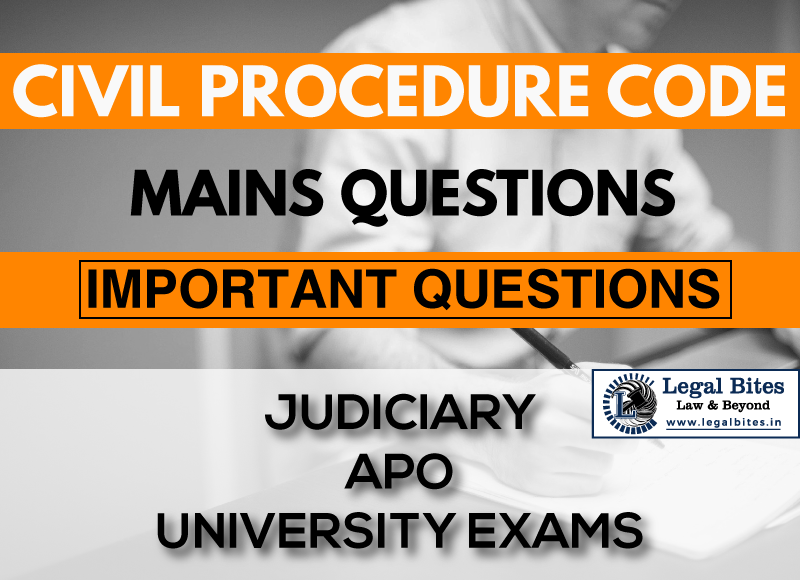What is the consequence of non-appearance of both the parties when the suit is called on for hearing?
Question: What is the consequence of non-appearance of both the parties when the suit is called on for hearing? [WB J.S. 1999] Find the answer to the mains question only on Legal Bites. [What is the consequence of non-appearance of both the parties when the suit is called on for hearing?] Answer It is a general principle of law… Read More »

Question: What is the consequence of non-appearance of both the parties when the suit is called on for hearing? [WB J.S. 1999] Find the answer to the mains question only on Legal Bites. [What is the consequence of non-appearance of both the parties when the suit is called on for hearing?] Answer It is a general principle of law that a proceeding is to be carried out in the presence of both the parties to a suit. But this can’t always be the case. Many a time, parties against whom the case...
Question: What is the consequence of non-appearance of both the parties when the suit is called on for hearing? [WB J.S. 1999]
Find the answer to the mains question only on Legal Bites. [What is the consequence of non-appearance of both the parties when the suit is called on for hearing?]
Answer
It is a general principle of law that a proceeding is to be carried out in the presence of both the parties to a suit. But this can’t always be the case. Many a time, parties against whom the case has been filed may not appear in the court even after the issuance of summons.
The presence of the parties is crucial to conduct the court proceedings therefore when a party does not appear in the court it has an adverse effect on the party that does not appear. Order IX under the schedule provides for the appearance of the parties before the court and lays down consequences of non-appearance in a threefold manner, viz. (i) when both parties have not appeared, (ii) when the plaintiff has not appeared and (iii) when the defendant has not appeared.
When Both Parties Do not Appear
When neither the Plaintiff nor the Defendant appears before the court and the suit is called for hearing then the court is empowered to dismiss the suit under Rule 3 of Order IX of the Code of Civil Procedure. The basic rule under Rule 2 of Order IX is that, when both the parties do not appear, the suit should be dismissed which means that the plaint should be dismissed. However, the provision uses the word ‘may’ which makes it a discretionary power at the hands of the judge. It means that if a judge has reason to believe that the case should not be dismissed, he can adjourn it for a later date.
Rule 4 states that the dismissal of the suit under this rule does not put a bar on filing a fresh suit on the same cause of action. Plaintiff is also entitled to apply to set aside the dismissal if he is able to show sufficient cause for his absence. If the court is satisfied with such a cause then it may set aside the dismissal order and schedule another day for the hearing of the suit.
Let us say the court receives a high profile case whereby a Multi-national Company has been sued for negligence by one of its customers or even employees. The court finds that the alleged negligence of grave nature and if true might affect a lot of lives. For instance, the Nestle Maggi situation, where Maggi Noodles was alleged to contain the metal lead. In such a scenario, the court may adjourn the suit for a later date even if the parties have failed to appear.
A dismissal under this rule as held under Gh. Qadir Dar & Anr. v. Punjab National Bank, AIR 2012 J&K 35 is justified only where neither party appears. Thus, if the plaintiff or his agent or his pleader duly instructed is present, the fact that no evidence is adduced will not enable the Court to order a dismissal under this rule.
In H.K. Shah v. T.S. Bhasin AIR 1972 J&K 19, it was clearly held by the court that the parties have a right to be heard and given appropriate opportunities for the same. If the court fails to provide sufficient opportunities to be heard before passing an order of dismissal of the suit, such order is ultra vires and can be set aside.
Important Mains Questions Series for Judiciary, APO & University Exams
- CPC Mains Questions Series: Important Questions Part – I of X
- CPC Mains Questions Series: Important Questions Part – II of X
- CPC Mains Questions Series: Important Questions Part – III of X
- CPC Mains Questions Series: Important Questions Part – IV of X
- CPC Mains Questions Series: Important Questions Part – V of X
- CPC Mains Questions Series: Important Questions Part – VI of X
- CPC Mains Questions Series: Important Questions Part – VII of X
- CPC Mains Questions Series: Important Questions Part – VIII of X
- CPC Mains Questions Series: Important Questions Part – IX of X
- CPC Mains Questions Series: Important Questions Part – X of X

Admin Legal Bites
Legal Bites Study Materials correspond to what is taught in law schools and what is tested in competitive exams. It pledges to offer a competitive advantage, prepare for tests, and save a lot of money.
